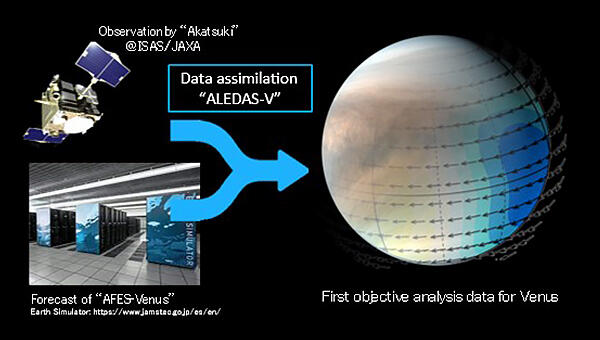A research team led by Dr. Yukiko Fujisawa, a researcher at the Research and Education Center for Natural Sciences, Keio University, Professor Norihiko Sugimoto of the Faculty of Law, Keio University, in collaboration with associate senior researcher Shin-ya Murakami of the Japan Aerospace Exploration Agency (JAXA), Professor Masahiro Takagi of Kyoto Sangyo University, Professor George Hashimoto of Okayama University, Associate Professor Hiroki Kashimura and Professor Yoshi-Yuki Hayashi of Kobe University, has succeeded in creating the world's first objective analysis data (meteorological data set) of the Venusian atmosphere by adding observation data obtained from JAXA's Venus Climate Orbiter Akatsuki to the data assimilation system for the Venusian atmosphere.

Provided by Keio University
Venus is often called Earth's "twin" due to its similar size, density, and distance from the Sun, but the motion of its atmosphere remains a mystery, and it is possible that more unexpected phenomena will be discovered in the future that are different from what we know on Earth. The research team has been developing a numerical simulation of Venus's atmosphere, the Venus Atmospheric General Circulation Model "AFES-Venus," since before Akatsuki began its observations. They subsequently assimilated the horizontal wind velocity data obtained from Akatsuki observations into an atmospheric general circulation model using the Venus atmospheric data assimilation system, "ALEDAS-V." Since the observed data have a spatiotemporal bias, they created objective analysis data over the entire globe by assimilating the data.
When they examined this objective analysis data, they confirmed that it accurately reproduces the observed planetary-scale atmospheric waves (thermal tides) on a global scale. Thermal tides are a phenomenon that have been difficult to reproduce using atmospheric circulation models alone, and the fact that they were reproduced demonstrates the validity and usefulness of the objective analysis data in the study. Data assimilation requires an enormous number of calculations, which the research team achieved by using the Japan Agency for Marine-Earth Science and Technology's supercomputer, "Earth Simulator."
"The results of this research will serve as a bridge between observational research and numerical simulation research," says Fujisawa. "It will be interesting to see if the deficiencies in observations and numerical simulations can be compensated for to reveal new facts that could not be seen from only one side. We hope it will help us unravel the mysteries of the Venusian atmosphere."
■ Thermal tides: Planetary-scale waves excited in the atmosphere by the movement of a region heated by the sun. The earth is also heated during the day and cooled at night, which excites tides with daily and semi-daily cycles. Observations have shown that thermal tides also exist on Venus. In the Earth's oceans, there are tides related to the ebb and flow of the tides, which are produced by the gravitational pull of the moon and are distinct from thermal tides.
Journal Information
Publication: Scientific Reports
Title: The first assimilation of Akatsuki single-layer winds and its validation with Venusian atmospheric waves excited by solar heating
DOI: 10.1038/s41598-022-18634-6
This article has been translated by JST with permission from The Science News Ltd.(https://sci-news.co.jp/). Unauthorized reproduction of the article and photographs is prohibited.




